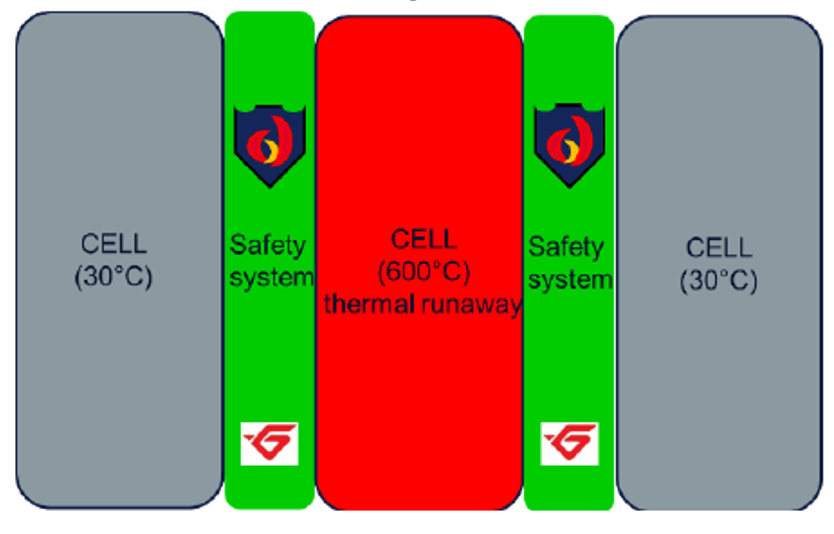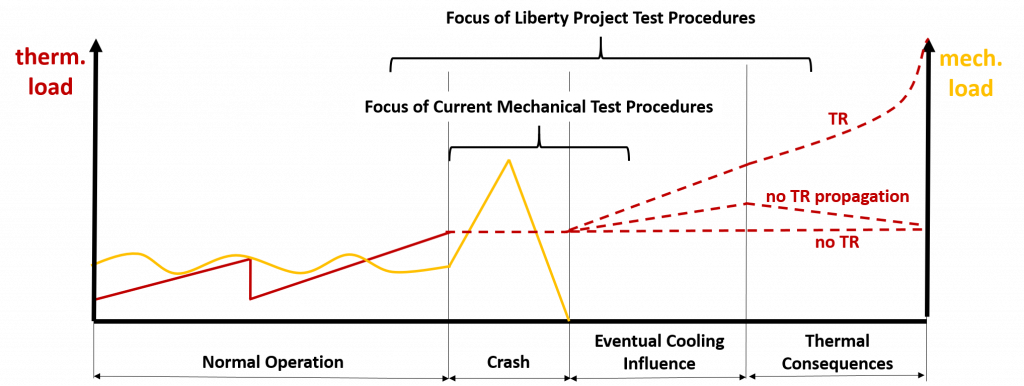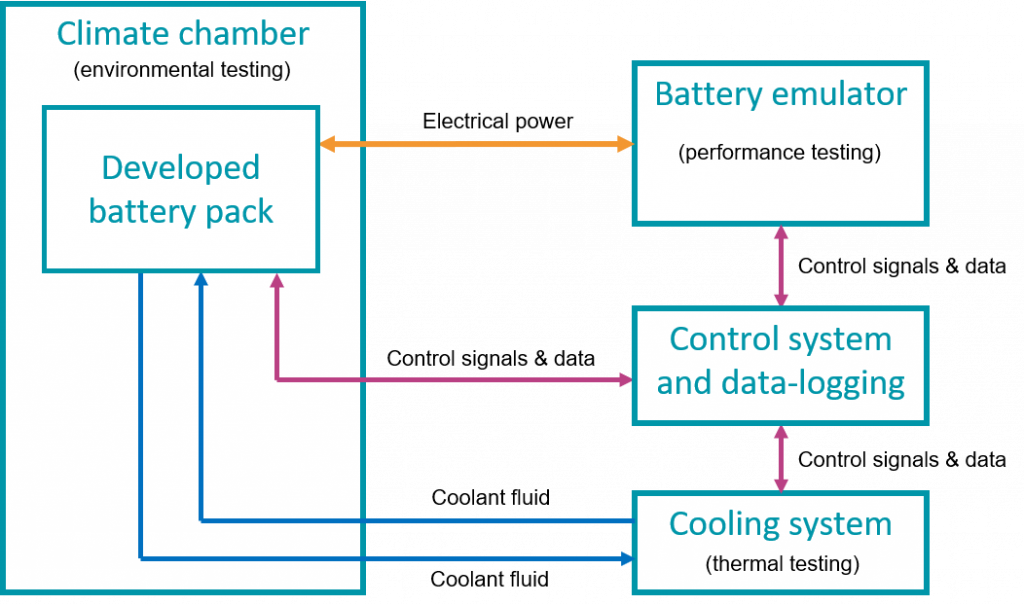LIBERTY Innovations
- Requirements design criteria of the battery system and test plan
- Battery system design
- Battery system hardware component development
- Battery management system and state estimator development
- Development of advanced test procedures for safety and performance
- Integration, testing and concept validation on cell, cell stack, battery system and EV level
- Overall techno-economic assessment, recycling and LCA
Key activities:
The activities for Requirements design criteria of the battery system and test plan form the basis for further developments in the work packages that build on them. Within the framework of the activities, an intensive exchange between the partners on the envisaged goals and technical implementation options is promoted.
The definitions and target values defined here are regarded in the consortium as a binding basis for the development and also validation of the components and the battery system.
A dynamic approach will be implemented by comparing and revising the results of the initial coordination of requirements towards the end of the first year of the project.
Goals:
- to define and consolidate the requirements and design criteria of the battery system to ensure the battery system will meet the targets (range, charging time, mileage, etc) and can be integrated seamlessly in the EQC.
- to make a test plan in which the tests are linked to the requirements and design criteria and allow a validation and evaluation of the implemented battery system.
- to maintain focus on the defined targets during the development phase and provide a process for realignment.
Planned results and outcomes:
- Report containing the design criteria of the battery system based on first life, second life, LCA, recycling and TCO targets.
- Report containing the consolidated requirements for the battery system based on vehicle and technical targets.
- Test plan covering the requirements.
- Report on optimised requirement specification, technical progress, identified problems and solution strategies.
Key activities:
The main objective for Battery system design is to develop a battery system design that allows for weight reduction by 20%, meets the targets of optimal TCO and cell cycle life, and considers fast charging (up to 350kW) as well as safety requirements with the increased voltage level from 400 to 800V. The WP2 covers the following activities:
- Conceptual battery system design that achieves the targets and requirements;
- Analysis of the cell properties and cell level modelling based on electrical, thermal, mechanical, and thermal runaway behaviour;
- A detailed battery system design (electrical, thermal, mechanical) according to the component design.
Goals:
- Achieve a range of 500 km on a fully charged battery pack through optimal battery system design, smart implementation of battery cells with an energy density of ≥250 Wh/kg and innovative cell-to-pack approach to reduce volume and weight or to maximise the energy density for the same volume;
- Allows for fast charging up to 350kW considering the battery system voltage level increase from 400 to 800V;
- Achieve an ultimately safe battery system to guarantee high insulation and to limit the potential thermal runaway;
- Allows for optimal cell cycle life;
- Achieve sustainability over the battery pack’s entire life cycle by considering eco-design principles in the design phase.
Planned results and outcomes:
The outcome is lighter, longer range, safer design of a battery pack including mechanical, thermal, electrical CAD design which will be later prototyped. This will enable to optimize further in early design stage.
Key activities:
Battery system hardware component development aims to design and produce several components of the battery system for the integration in the demonstrator vehicle. The components covered are key parts of the whole system for the achievement of the project targets. The following activities are covered:
- Design of the optimal cell arrangement in the battery pack.
- An optimised lightweight housing to contain the battery cell arrangement and the integration with other systems.
- Sensing and high-voltage electrical subsystem for an increased operating voltage of 800V.
- A new thermal management system for optimum operation of the battery cells with an active safety system.

Goals:
The goals for the different activities are fully aligned with the project objectives and the different components contribute in a broad scope:
- For the increased range of the vehicle, the battery pack design and components provide optimum packaging and energy density thanks to the selection of the cell arrangement and reduction of weight.
- For the ultra-fast charging, the electrical system will be designed for 800V and the thermal management systems must be capable of provide proper temperature range.
- The battery pack with an optimised temperature control, an active safety system and new sensing developments will contribute to ensure the required levels of safety and durability.
- All the components will take into account sustainability for their design.
Planned results and outcomes
The planned outcome is the production of components and systems to answer the project objectives that will be finally integrated in the battery pack in Work Package Integration, testing and concept validation on cell, cell stack, battery system and EV level.
Key activities:
The main objective of Battery management system and state estimator development is the development of a flexible battery management system (BMS) with the focus on the realization of the overall project targets (range improvement, short charging time). In addition, novel AI-based state estimators (State-of-health, State-of-safety, State-of-charge, State-of-function) will be developed.
The BMS implementation and testing will first be performed in a lab environment, before all components will be validated in the full-electric demonstrator vehicle.
The following activities are covered:
- The definition of the Battery Management System (BMS), where the high-level requirements are brought to component level for electronics, functionality and interfaces.
- The development of improved battery state estimators.
- Improved state of safety estimation algorithms.
- Improved battery state estimators, based on adaptive and predictive techniques, such as neural networks and artificial intelligence.
- The development of the Battery Management System (BMS) hardware (HW) and software (SW)
- Data logging and mining to support HW and SW BMS improvements.
- BMS software capabilities for remote maintenance and troubleshooting.
- BMS master hardware development for multi-domain applications.
- BMS slave development incl. definition of components for measurements (e.g., cell voltage, cell temperature).
- The assembly and testing of all BMS-related components.
Goals:
- Deriving a comprehensive subset of component-level requirements for the battery management system based on the overall system requirements.
- Improving battery state estimators that will enable an early battery failure detection and prevention. Advanced monitoring functions will lead to shorter charging times and increased battery lifetimes. Precise state estimators will contribute to enhanced range, lifetime, safety and failure prediction.
- Implementation of extended secure communication interface functions that will enable the use of cloud infrastructure for data collection, data mining, and battery passport capabilities.
- The demonstration of a fully working and tested BMS prototype in a lab-environment.
Planned results and outcomes:
The planned outcome of this workpackage is a fully working BMS demonstrator that is ready for integration into the vehicle. This also includes the running software algorithms for the state estimations as well as the connection to the cloud infrastructure.
Key activities:
Development of advanced test procedures for safety and performance is divided in two main activities.
- Development of advanced battery performance testing procedures (electrical and thermal performance as well as accelerated life tests) under severe operating conditions (load cycles, climate conditions) taking high-power fast charging (up to 350 kW) and cost-effectiveness into account.
- Development of advanced testing procedures for battery safety testing (crashworthiness, thermal runaway and functional safety level) for improved safety beyond standard operational conditions (accident, functionality problem, etc).
Goals:
Advanced performance testing:
Accelerated lifetime testing on cell level with focus on the influence of fast charging is investigated via a hybrid approach (testing and prediction modelling). On the one hand the focus of advanced electric-thermal testing is set on model based testing on cell level which is then upscaled to battery pack level real life performance. At the other hand hardware in the loop (HIL) setup for cell stack testing is evaluated. At BMS level protocols for performance testing of the electronics (measurement accuracy,SoC estimations validation, response time analysis, threshold validation, etc.) are developed.
Advanced safety testing:
A thermal runaway simulator is adapted for the cells used in the project for benchmark of thermal safety and avoidance of thermal runaway propagation. On cell stack level combined test procedures (mechanical and related thermal runaway) are developed for efficient and safe crashworthiness design. At BMS level the full set of BMS safety tests are defined, mainly in terms of Over-Voltage, Under-Voltage, Over-Current, Over-Temperature, Under-Temperature, Open-Wires, etc.
Planned results and outcomes?
The developed test proposals are used for battery classification within the project. Based on the feedback further refinement is done and on new testing regulation standards for battery pack safety, performance testing will be derived.

Key activities:
The main objective of Integration, testing and concept validation on cell, cell stack, battery system and EV level is to test and validate the cells, cell stack and complete battery system with respect to functionality, performance and safety. The battery system validation will first be performed in a lab environment, whereafter it is validated in the full-electric demonstrator vehicle.
Following activities are covered:
- The assembly of the complete battery system, including functional testing;
- Performance and safety testing on cell, cell stack and battery system level;
- Integration and functional testing of the complete battery system in the demonstrator vehicle;
- Performance testing on vehicle level and comparison against the state-of-the-art demonstrator vehicle.
Goals:
- Bring together all the different parts that are tested and/or developed within the different workpackages (cells, thermal management system, BMS, battery housing…). Then, validate the functionality according to the developed test plan. The result will be a functional battery system;
- The performance and safety testing is used for the life prediction of the battery system and for the development of components and systems within other workpackages;
- Integration of the complete battery system in the demonstrator vehicle. After the mechanical and electrical integration, the functional testing ensures that the interfaces between the demonstrator vehicle and battery system are functioning properly;
- The performance testing has to demonstrate that the new developed battery system fullfills the relevant customer requirements such as fast-charging, range, efficiency and performance under real road conditions.
Planned results and outcomes:
The planned outcomes are: the validation of the newly developed battery system at vehicle level, the validation of the newly developed test procedures and the demonstration of the progress against the state-of-the-art demonstrator vehicle.

Key activities:
Overall techno-economic assessment, recycling and LCA is about the battery pack recycling, life cycle assessment as well as life cycle cost investigation. ACCUREC Recycling GmbH will lead the investigation of recycling and reuse of Liberty battery system. Mondragon Goi Eskola Politeknikoa S. Coop will lead the life cycle assessment of Liberty battery system. Brussels Research & Innovation Center for Green Technologies will lead the total cost of ownership assessment of Liberty battery system.
Goals:
The goal of recycling and reuse investigation is to develop a dedicated recycling and dismantling process which ensures maximum reuse of components and maximum recycling of material.
The goal of life cycle assessment investigation is to ensure 20% reduction in environmental impacts.
The goal of total cost of ownership assessment is to estimate cost during the whole first life of the battery pack.
Planned results and outcomes:
- Recycling solution of Liberty battery system.
- 20% reduction to the environmental impacts during the life cycle assessment of battery system.
